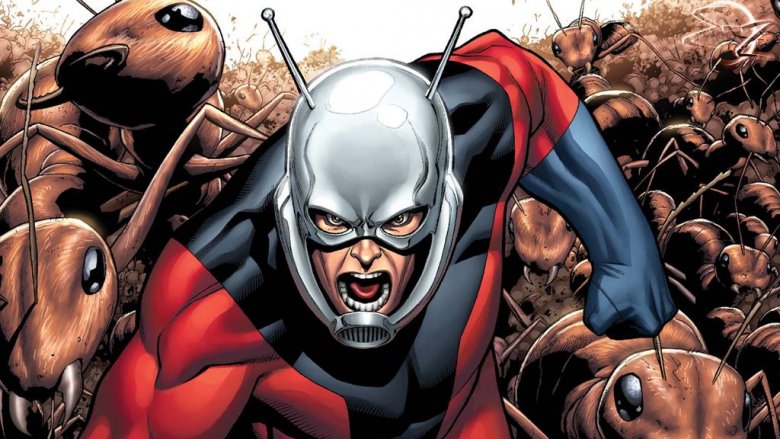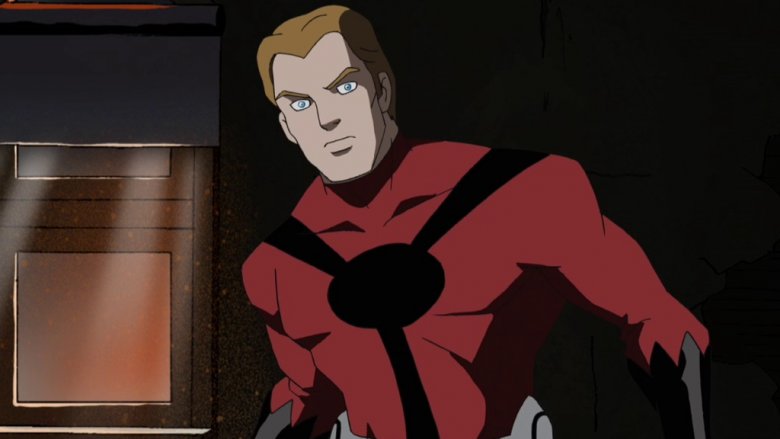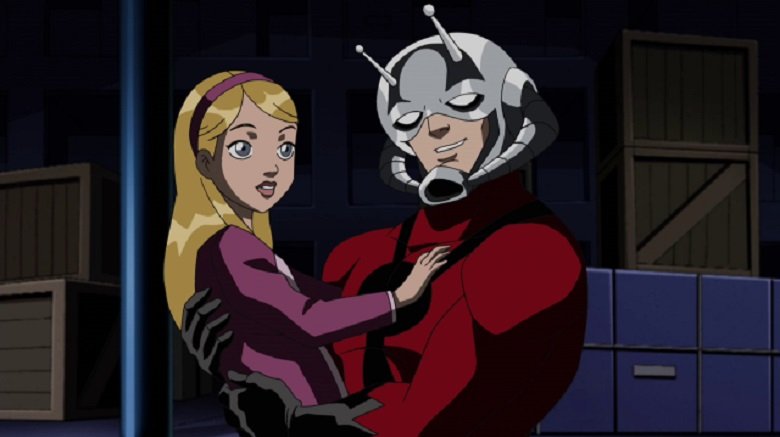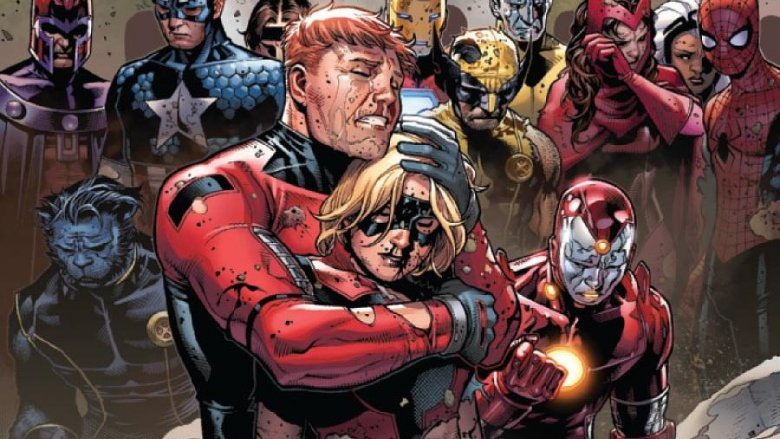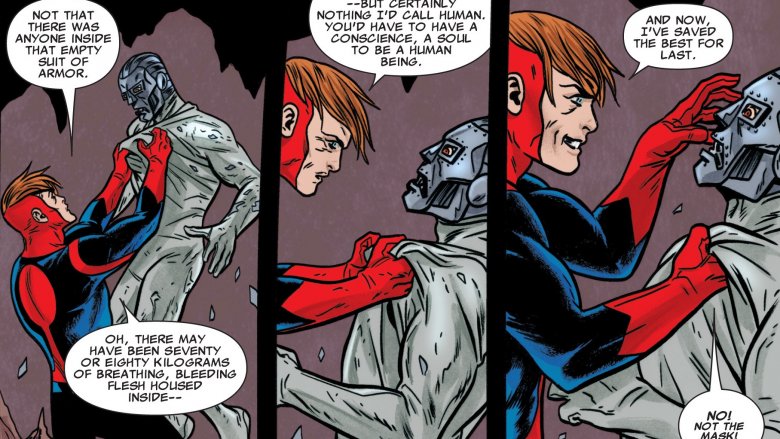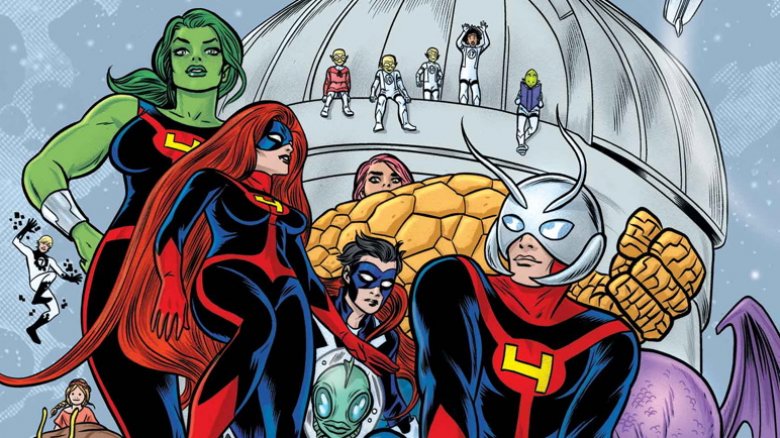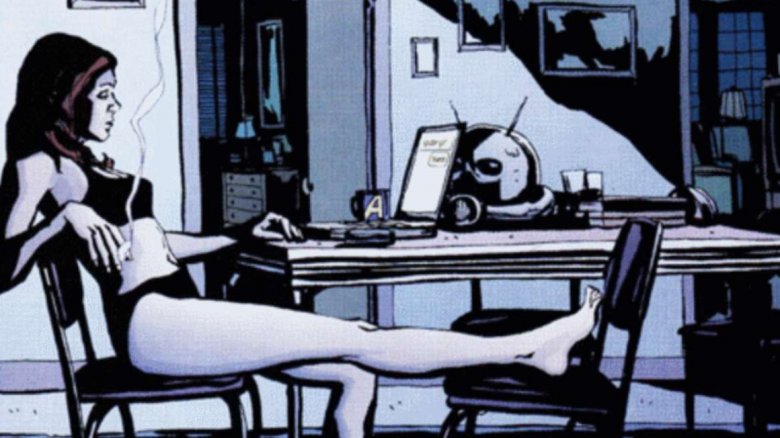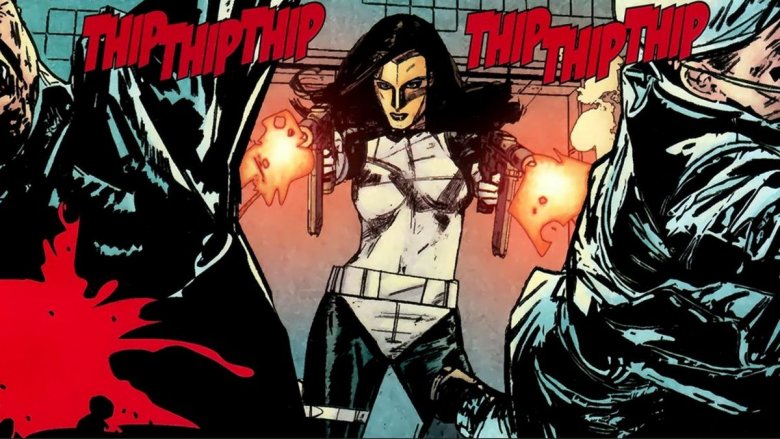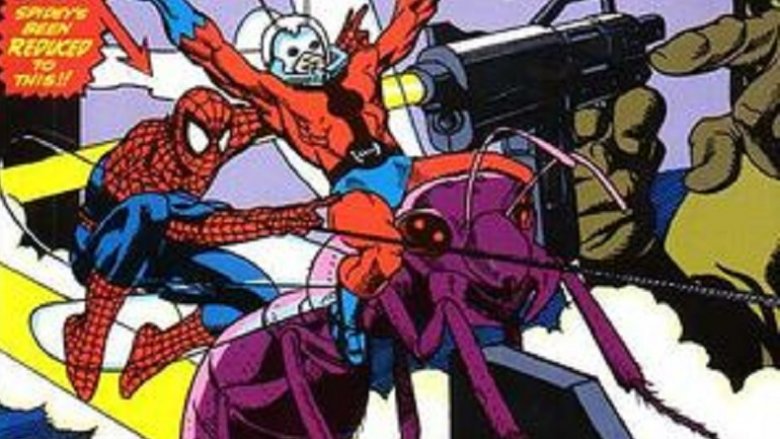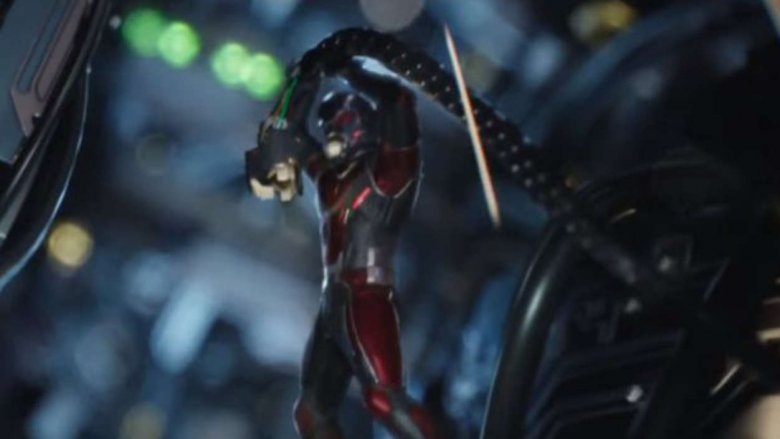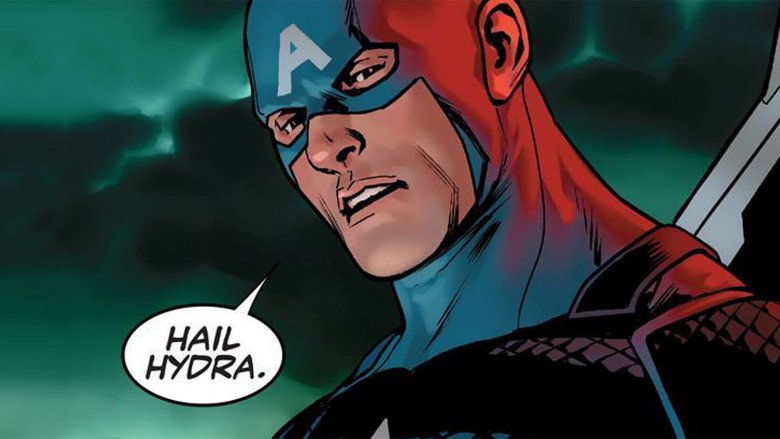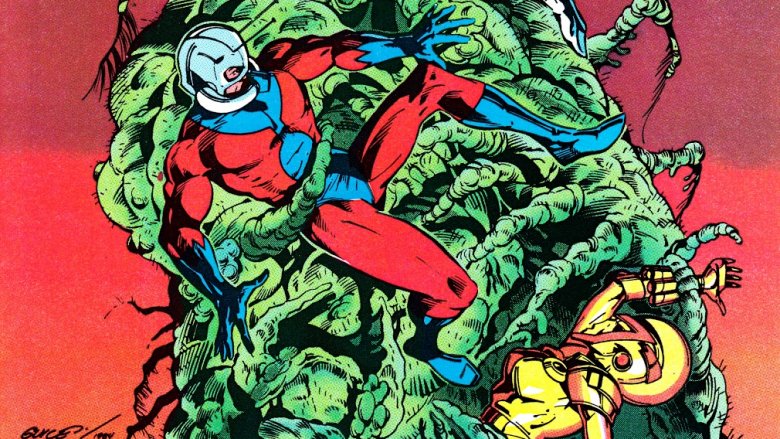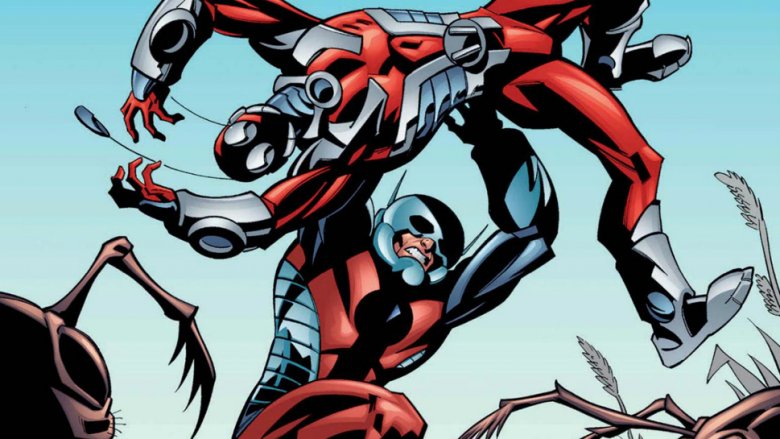The Untold Truth Of Ant-Man
Thanks to his role in the Marvel Cinematic Universe, Scott Lang — the second hero to take up the mantle of Ant-Man — is perhaps even more famous than the original. In the comics as in the films, Dr. Henry Pym was the inventor of the technology (powered by his Pym Particles) that allows the user to gain or shed mass, growing to the size of a giant or shrinking to that of, well, an ant (or even smaller). Pym, a founding member the Avengers, only bore the moniker himself for a short time before moving on to the guises of Yellowjacket and Goliath — so, while he may be the original, Lang is the longest-tenured Ant-Man by far.
The character's origin and adventures in the pages of Marvel comics are quite similar to what's been presented in the MCU — but of course, there are a great many differences and odd asides that never could have made it to the screen for one reason or another. Let's take a look at the long and sometimes very weird history of Scott Lang, the petty-thief-turned-Avenger, a man whose love for his friends and family knows no bounds, a hero with more sheer nerve than most — the astonishing Ant-Man.
He first appeared as a lowly security tech
When Lang made his comics debut in Avengers #181 in March 1979, it was in no way evident what a major player in the Marvel Universe he would become. The issue begins with Wonder Man (Simon Williams) and the Beast (Hank McCoy), who had joined the Avengers during a brief hiatus from the X-Men, going out to take in a movie. The two have a deep discussion about the psychology of superheroes and their role in society, but upon their return to Avengers Mansion, their reverie is shattered when Wonder Man's security key sets off an alarm.
Managing to gain entry, the irate hero begins hassling the only security tech he can find — Lang, who we will later find out is an electrical engineer and ex-con hired by Tony Stark. Although his appearance in the issue is brief, it would become obvious in short order that this was no one-off character. The very next month, Lang took center stage in Marvel Premiere #47, the cover of which declares, "Featuring the astonishing Ant-Man" — a guise in which Pym had not appeared for quite some time. It was this issue that filled in his criminal background, his recruitment by a sympathetic Stark, and the circumstances that led to his theft of Pym's Ant-Man suit. Unlike in the 2015 film Ant-Man, however, his motivations were quite a bit different from simply having the need for a little cash.
He became Ant-Man to save his daughter
In the comics as in the movies, Lang had turned to a life of crime to support his family, although he was not exactly a master burglar. In fact, he proved to be a pretty crappy criminal, quickly earning himself a trip to the Big House which ended when he received parole for good behavior. It's safe to say that the comics version of Lang never would have considered a return to the criminal lifestyle if not for one key development: the rare heart ailment with which his daughter Cassie was afflicted.
Lang had planned the theft of Pym's technology out of sheer desperation, as the only doctor capable of curing Cassie — Dr. Erica Sondheim — had been kidnapped by the industrialist Darren Cross, who suffered from a heart condition of his own. His attempts at self-treatment had mutated him into a super-strong beast. As Ant-Man, Lang is able to infiltrate his laboratory and battle him to a standstill. The fight proves to be too much of a strain on Cross' heart, and the villain apparently dies after this first battle with Lang (although we all know how that goes in comics). Sondheim is then able to save Cassie, and Lang prepares to return to prison... but it's not to be. Impressed by his cunning and determination, Pym allows Lang to keep the suit and become the new Ant-Man — provided, of course, that he only use his powers to defend the law rather than break it.
Cassie was murdered by Dr. Doom
Other than being uncommonly pure of heart, Lang is defined as a character by his love for Cassie. After her dad takes up the Ant-Man mantle, the child has occasion to spend time around the most famous heroes of the Marvel Universe, eventually moving into Avengers Mansion with Lang after her parents' divorce. It's during this time that Cassie secretly exposes herself to Pym Particles, having gotten it into her head that she, too, wants to become a hero — which she does, taking on the moniker Stature and later joining the Avengers herself.
Unfortunately, this development sets her father up for the greatest tragedy of his life. During the 2010-2012 event known as The Children's Crusade, Stature (as a member of the Young Avengers) travels back in time with the assistance of the Scarlet Witch in order to save Lang from his previous "death" in a horrible accident involving fellow Avenger Jack of Hearts. Although she is successful, the supervillain Doctor Doom takes the opportunity to imbue himself with Scarlet Witch's reality-altering powers, proceeding to take on both the Avengers and X-Men in an all-out brawl. Although the two teams are able to defeat Doom, the battle is not without cost. Stature is mortally injured in the fight, dying in her father's arms as his shocked teammates and friends look on.
He later beat Doom within an inch of his life
A couple of years after that tragic event, Lang gets his chance for revenge. Insane with power and in possession of the device known as the Cosmic Power Siphon — which is capable of transferring the power of cosmic beings to his mortal form — Doom and his minions put a plan into motion to take over the world, but are opposed by the Fantastic Four, the Future Foundation (of which Lang is a member at the time), and others. The heroes are able to counter Doom's strategy and gain control of the Siphon — and that's when Lang, his powers enhanced by the device, makes his move.
Impervious to the blasts from Doom's gauntlets, Lang proceeds to crush them with his bare hands before stripping Doom of his armor and, well, simply beating the crap out of him. After chastising the villain for his attempt to gain godlike power, Lang realizes that he, just as flawed and mortal, doesn't deserve it either, and destroys the Siphon. To add insult to injury, the Watcher and the Living Tribunal — who have been keeping tabs on the proceedings — arrive to destroy Castle Doom and mete out the punishment of Doom's facial scars (which he had previously found a way to heal) becoming permanent. Lang stops just short of killing the villain — but makes it clear that if Doom were ever to mess with him or his family again, he would show no such restraint.
He's been a member of the Guardians of the Galaxy and Fantastic Four
Shortly after this event, the Future Foundation — Lang, She-Hulk, the Inhuman Queen Medusa, and "Ms. Thing" Darla Deering — are pressed into service as replacements for the Fantastic Four, Marvel's First Family having been forced to visit another dimension in order to address an issue with Reed Richards' powers. The substitution is only supposed to last for four minutes, but you know how trips to alternate dimensions always have unforeseen difficulties. Of course, Lang leaves the team when the original FF returns, but this wouldn't be his only stint as a member of one of Marvel's premier superhero teams other than the Avengers.
When Lang just kind of feels like getting away from it all — as in, away from the planet Earth — he stows away on the Guardians of the Galaxy's ship during one of that team's visits to "Terra." Of course, it doesn't take the Guardians long to discover their guest, but rather than summarily ejecting him, they welcome Lang aboard and invite him to join the team, which he does. The Avengers, the Fantastic Four, the Guardians — those are some pretty impressive credentials for a one-time petty thief.
He dated Jessica Jones
The romantic history of Jessica Jones and Luke Cage, a.k.a. Power Man, is as... complicated in the comics as it is in the characters' respective Marvel Netflix series. The pair start off as crime-fighting partners, becoming close friends before developing a relationship of a more physical nature. This begins as a drunken one-night stand (this is Jessica Jones we're talking about, after all), after which the pair decide to take a little time to rethink their relationship. During their hiatus, Jones is set up with a potential new love by her close friend Carol Danvers, a.k.a. Captain Marvel — none other than Scott Lang.
Unfortunately for Lang, it turns out to be nothing but a brief fling, as Jones subsequently discovers that she's pregnant with Power Man's child. She breaks off her relationship with Lang and reunites with Cage, eventually giving birth to baby girl Danielle (named after Cage's best buddy and fellow Hero for Hire Danny Rand, a.k.a. Iron Fist) in Doctor Strange's Sanctum Sanctorum. After the birth of their daughter, Cage and Jones are married, and although Jones keeps her maiden name, she does briefly go by the moniker of Power Woman in honor of her new husband. As for Lang, he never could catch a break marriage-wise — but if Marvel's writers had gotten their way, his luck could have been so very much worse.
His ex-wife was almost a supervillain
Whitney Frost, the supervillain known as Madame Masque, was a part-time nemesis (and part-time love interest) of Tony Stark for decades in the pages of Marvel comics. She ostensibly met her end in a 1989 issue of Iron Man, murdered by a mysterious party in a whodunit-style mystery that was to have a shocking reveal. Frost's murderer stole her signature mask, and Iron Man writers Bob Layton and David Michelinie intended for her killer to become the new Madame Masque — a villain with ties not only to Stark, but to Scott Lang, as well.
Their idea was that Rae La Coste, Stark's girlfriend at the time of the murder, was to be revealed as the killer — and further, they then intended to drop the bomb that La Coste was actually Lang's ex-wife and Cassie's mother. The writers' plan never came to fruition, however (perhaps the Mighty Marvel's editors felt that the storyline was becoming too soap opera-esque), and Frost's death was later retconned in true Marvel fashion, with the murdered Masque having simply been a clone. It wasn't until a 2003 issue of Avengers that Lang's actual ex, Peggy Rae — her surname perhaps being a vestige of this lost storyline — was introduced by comic legend Geoff Johns.
He accidentally shrunk Spider-Man
It seems like a bit of a missed opportunity on Marvel's part to have never given Spider-Man and Ant-Man a team-up series, but their only adventure together made up for it. The wackiness went down in a 1990 issue of Amazing Spider-Man Annual, in a story hilariously titled "Quark Enterprises! Or, Honey, I Shrunk the Non-Mutant Superhero!" (Spidey, by the way, is not a mutant but a mutate — subtle difference.)
The fun begins when Peter Parker and Scott Lang arrive at the Tomorrow Exhibition to check out Tony Stark's new Quark technology — but, unfortunately, some attendees have nefarious plans. A group of armed terrorists, intending to steal the tech, knock out the exhibition's guards and put the place under lockdown.
Parker and Lang, each unaware of the other and the terrorist incursion, happen to suit up right around the corner from each other (Lang so that he can investigate the Stark tech undisturbed, and Parker so he can be on time for a meetup with Mary Jane Watson), and an accidental discharge of Pym Particles from Lang's suit results in Spidey shrinking down to the same tiny size as Lang. After fending off an attack from an actual spider, ol' webhead makes his way to the Quark device, where he finds Ant-Man under attack from the terrorists. The two heroes handle the situation, but Spidey continues to shrink, and in later issues he finds himself going on a solo adventure through the Microverse.
His Civil War moment with Iron Man played out differently
One of the more hilarious moments (and there are many) of the titanic airport brawl in Captain America: Civil War comes when Lang tries pulling a trick on Iron Man — a trick that had previously worked out pretty well for him while fighting the Falcon in his first solo flick. Lang shrinks down enough to slip inside Stark's armor, and begins wreaking havoc on the sensitive electronics therein while chastising Stark (who is eventually able to eject Lang by activating his armor's fire suppression system). Civil War screenwriters Christopher Markus and Stephen McFeely may have gotten the idea from a 1980 issue of Iron Man in which Lang pulls the same trick — but for a very different reason.
While attempting to cure Bruce Banner of his Hulk condition, Stark provokes the ire of Banner's alter ego, and is only able to defeat the Green Goliath by channeling all of his armor's power into a single punch. Not only does the physical strain cause Stark to collapse, but the power drain locks down his armor, rendering him immobile and threatening his life. Fortunately, Lang deduces what the problem is and infiltrates the armor, reattaching damaged cables and enabling Stark to power back up. He'd only been an Avenger for about a year at this point — but there aren't many better ways to prove yourself as a valuable team member than saving Iron Man's life.
He helped defeat HYDRA Cap
The so-called "HYDRA Cap" storyline was among the most controversial in Marvel's history. In the Secret Empire event, all of history has been rewritten by a sentient Cosmic Cube, HYDRA has been made the dominant force on the planet, and Steve Rogers is its Supreme Officer. When the Cube is shattered into fragments (with the memory of the original Rogers and his world trapped inside it), it looks like the Avengers' bid to return the world to normal has utterly failed. But HYDRA Cap, mad with power, reassembles the Cube save for one shard, which is in the possession of Sam Wilson (at the time serving as Captain America).
As Ant-Man and Winter Soldier (Bucky Barnes) watch, Wilson hands over the final fragment to Rogers — but it's a ruse. Lang helps Barnes go sub-atomic, penetrating the chestpiece in which Rogers has housed the Cube. Within the Cube, Barnes is able to reach the real Rogers, extracting him from his confinement and returning him to the real world. Facing off against his doppelgänger, the real Steve Rogers then does what he does best — roundly beat the hell out of a fascist.
He fought Eldritch horrors alongside ROM the Spaceknight
ROM: Spaceknight was one of Marvel's weirder titles, created to tie in with a line of toys produced by Parker Brothers. The Spaceknights were once ordinary citizens of the planet Galador, which had come under siege by an insidious, shape-shifting alien race known as the Dire Wraiths. To combat the threat, a contingent of Galadorians volunteered to be permanently encased in powered suits of armor, hunting the Wraiths down throughout the universe and banishing them to Limbo with powerful weapons known as Neutralizers.
In ROM #58, the Spaceknights require a little miniature-sized assistance when the Wraiths attempt to contaminate Earth by altering the physiology of the lifeforms in and around Beaver Lake, Ontario. Fortunately, their focus is on a large colony of ants — and Scott Lang happens to be on the scene, having shown up to investigate the phenomenon as a scientist. He and Spaceknights ROM and Starshine shrink down, taking on hordes of ants — transformed into Lovecraftian horrors by the Wraiths — which are only held off by an equal number of friendly, non-transformed insects summoned by Lang. ROM and Starshine manage to find the source of the threat, and ROM is able to use his Neutralizer to create an antibody that returns the infected creatures to normal.
There was an "irredeemable" third Ant-Man
Lang was, unfortunately, not the last to don the Ant-Man suit. Near the beginning of the Civil War event in 2006, low-level S.H.I.E.L.D. agent and moral vacuum Eric O'Grady has stolen the latest version of the Ant-Man suit after beating up Henry Pym, whom he had been tasked with guarding. Discovering the suit's powers, he uses it for such upstanding purposes as staging ant races, beating the ever-loving tar out of petty criminals, and watching unsuspecting women undress (including then-Ms. Marvel Carol Danvers).
Much more prone to using his shrinking powers to hide during a fight than to join the fray, O'Grady does have a few heroic moments, teaming up with the Avengers to battle Ultron and eventually joining the team known as the Secret Avengers under the command of James Rhodes/War Machine (who rightly mistrusts O'Grady and believes him to be unworthy of the Ant-Man mantle). During a battle against the villainous Descendants, O'Grady attempts to save the life of a mother and her child. He fails to save the mother, and — perhaps finally having a long-overdue crisis of conscience — gives up his life rather than hand the child over to the Descendants. Although it's later suggested that the O'Grady who perished may have been a Life Model Decoy, the "hero" known as the Irredeemable Ant-Man has not been seen since.
